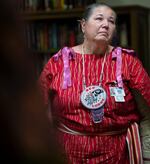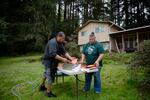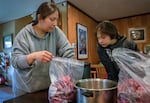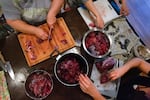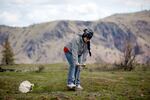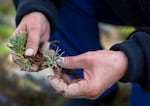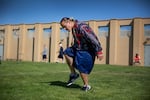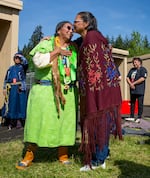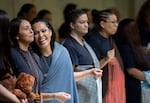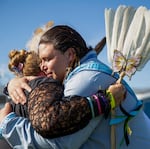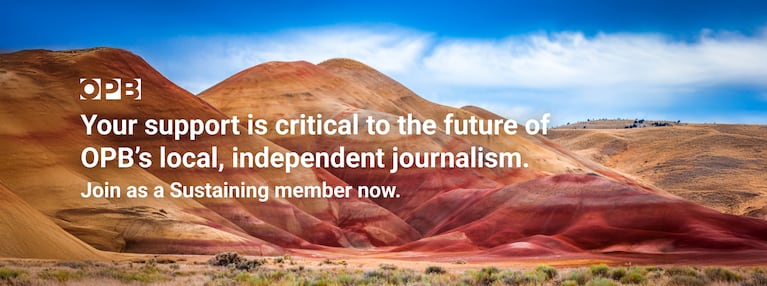A modest red home sits in a verdant alcove just off the Cascade Highway in Oregon City. On a chilly, mid-October morning, smoke drifted from the chimney, scenting the air outside as sun poked holes in the tree canopy. Inside, the fireplace crackled and stew simmered on the stove.
The slowness of the morning itself was not uncommon at the Red Lodge Transition Center, a halfway house for Indigenous women. It was, however, different.
“Our world has changed dramatically out here,” said Trish Jordan, executive director of Red Lodge Transition Services, the nonprofit that runs the home. “Everything got really, really quiet when we went into lockdown.”
In a typical year, the house is a hub for planning and coordinating cultural programming for Indigenous inmates across Oregon — everything from big annual bashes like powwows to more regular spiritual call-outs like sweat lodge ceremonies. Mid-October is around the time volunteers start winding down a packed summer calendar of events.
All of them were canceled this year due to the coronavirus.
“That was hard,” said Jordan, a registered nurse by trade, “but we recognize that this is a pandemic and it’s important for us to ... stay safe and that people in our prisons stay safe.”
The Oregon Department of Corrections barred all visitors — including family, friends, attorneys and volunteers — on March 12 in an effort to lock the virus out of the prison system. Minimizing inmates’ in-person contact, especially with outsiders, is widely agreed upon as an unfortunate but necessary step to shield the medically vulnerable inmate population from COVID-19.
Still, some of Oregon’s largest outbreaks have been connected to prisons and 18 inmates have died as of early December. The American Civil Liberties Union and the Prison Policy Initiative gave the state a D- for its response to COVID-19 in prisons and jails. (For what it’s worth, no state got higher than a D-.)
With infections on the rise heading into winter, it’s unclear when visitors will be allowed in Oregon prisons again. That’s stoked fears about long-term social isolation for the inmate population at large.
“If a person is prone to hopelessness, this would add to it,” said Ken Ball, chaplain at the Deer Ridge prison in Madras.
For Indigenous inmates, the pause on visitation carries the potential for cultural isolation as well.
“I’ve got letters [from inmates] that say, ‘Don’t worry about us. We’re going to be OK. We’re going to get through this,’” Jordan said. “They’re more worried about us than they are about what they’re going through.
“I’m just really concerned people are going to lose hope.”
Presiding tribal elders of the Umatilla and Warm Springs granted OPB special permission to document religious service programs inside and outside prison settings throughout 2019. What’s recorded in pictures and video illustrates the cultural void the coronavirus has created by showing what used to fill it.
Everybody’s their own strongest warrior
Religion and spirituality have long been rehabilitative tools in the prison toolkit. Religious or spiritual practice of any kind can help incarcerated people through hard times by forming community and identity. It can also reduce their likelihood to recidivate.
Meeting the mental, physical and spiritual needs of people inside and outside the criminal justice system can’t be a one-size-fits-all approach.
“Everybody is going to have a different experience in their hearts, in their spirits, in their souls than you or I do,” said Shana Cole (Klamath, Modoc, Yahooskin). She’s incarcerated at Coffee Creek in Wilsonville, and OPB met her there in 2019.
“Everybody is their own strongest warrior, ya know?” she said. “Nobody goes through the same thing.”

Joey Dexter, front right, drums with his family during powwow at Two Rivers Correctional Institute in Umatilla, Ore., Aug. 24, 2019.
Bradley W. Parks / OPB
Indigenous people generally see better health outcomes when they feel more connected to their culture and have ample space to address historical and intergenerational trauma, according to numerous studies. Some research also suggests these two factors can lower recidivism.
“I think that that’s one of the greatest things that we can experience, to see familiar faces, outside connection,” Cole said. “Also having people that aren’t going to sit here and judge us or correct us because we’re sitting here doing our ceremony.”
Related: Summer camp promotes healing through land, culture and connectedness for Indigenous youth
American Indians and Alaska Natives have the second-highest recidivism rate of any racial group in the United States. A 2018 study of 30 states, including Oregon, by the federal Bureau of Justice Statistics found more than 85% of American Indians and Alaska Natives were arrested within nine years of release from state prisons.
Recidivism feeds a cycle of incarceration organizations like Red Lodge are intent on breaking. The work is urgent, said Jordan (Creek).
“I personally know a grandfather who had a grandson in the same prison,” she said. “A lot of our women, they have children that are in the justice system or in the Oregon Youth Authority. It’s a form of genocide because if you look at the people incarcerated, most of them are of child-bearing age.”
Data on Indigenous people inside and outside the criminal justice system is minimal, incomplete and racially skewed. Native Americans are historically undercounted in census data and have often been miscategorized as non-Native by police and prisons.
What we can say for sure is that Native Americans have long been overrepresented in the criminal justice system. Indigenous people — especially Indigenous youth — are incarcerated at rates that far exceed their white peers.
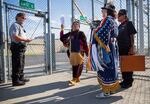
Rep. Tawna Sanchez (Shoshone-Bannock, Ute, Carrizo), center in burgundy, leads volunteers Lisa Graham (Comanche) and Gene Sanchez (Shoshone-Bannock, Ute, Carrizo) into Two Rivers Correctional Institute in Umatilla, Ore., for powwow Aug. 24, 2019.
Bradley W. Parks / OPB
Rep. Tawna Sanchez represents North Portland in the Oregon Legislature and has volunteered in prisons since she was a teenager. She co-founded Red Lodge with Jordan and chairs its board of directors.
“No matter what they’ve done, [incarcerated people] are still human beings who in some way, shape or form are struggling,” said Sanchez (Shoshone-Bannock, Ute, Carrizo). “If we could mitigate some of the struggle, that human being might be able to live again in the best way possible.”
Bringing Native American cultural programming to prisons has been an uphill climb that has taken decades. The pandemic-related pause on gatherings leaves behind an all-too-familiar void. Many of the Native American religious services today lauded as signs of prison’s increasing humanity were themselves crimes not long ago.
“It hasn’t been more than about 60 or 70 years, really, that people have been able to practice their culture and really celebrate their identity without being persecuted,” Jordan said.
Legal footing and 13 pairs of shoes
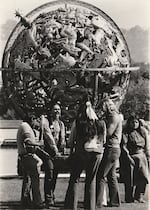
Tawna Sanchez, right, participates in the Longest Walk of 1978, a spiritual protest march from Alcatraz to Washington, D.C.
Courtesy of Tawna Sanchez
The American Indian and Red Power movements of the 1960s and ’70s helped drive a cultural resurgence and pride in Native American communities.
Sanchez and Jordan both took part in the Longest Walk of 1978, a spiritual protest march from Alcatraz to Washington, D.C.
“It took five months,” Jordan said. “I wore out 13 pairs of shoes.”
That year, Congress planned to take up 11 pieces of legislation to further the American colonial campaign to extinguish Indigenous people, land and ways. Among the bills was House Resolution 9054, which would have abrogated all treaties with Indian nations. None of the bills passed.
Related: How the U.S. broke its promises to Indigenous peoples of the Northwest
In the months after the walk’s conclusion, Congress passed the American Indian Religious Freedom Act, which underscored the religious and cultural rights of Native Americans, Eskimos, Aleuts and Native Hawaiians — including those in prison.
“There have been Bibles in prisons forever, so we have every right to have that ability to practice our spirituality,” Sanchez said. “We just didn’t have the vehicles, always, to make that happen.”
It didn’t flip a switch, she added, because the law had no enforcement behind it. “It meant we had to start fighting for it.”
The Lakota Oyate Ki Club had been organizing from within the Oregon State Penitentiary since 1968 and has since helped to build the suite of Native American religious services and accommodations available in Oregon prisons today.

Men cook salmon in the fire pit during powwow at Snake River Correctional Institute in Ontario, Ore., Aug. 25, 2019.
Bradley W. Parks / OPB
Phyll Mendacino began his sentence at OSP around the time the law passed.
“All of us had to fight to get what we got now,” said Mendacino (Northern Cheyenne).
He was there for the prison’s first sweat lodge and its first powwow. OPB met him at Two Rivers in Umatilla, which in 2016 became the last Oregon prison to begin hosting powwows.
“The younger people who want to learn their language, their songs, their culture, we want to give them a taste in prison,” Mendacino said, “so that they’ll be able to go out there and hopefully follow what they learned in here.”
A consistent, non-judgmental presence
Mable Jackson (Modoc, Hupa) grew up in Northern California and moved to Oregon in the ’80s, splitting with her family. She said that’s when she began losing touch with the spiritual practices she knew as a child.
“That really separated me from … wanting to learn anything after that, any kind of culture,” she said.
Jackson met Trish Jordan and Tawna Sanchez the first time she was incarcerated at Coffee Creek in the early 2000s. She recidivated after her release and returned to Coffee Creek in 2011.
“Trish and Tawna were still there, doing what they do,” she said.

Women gather with tribal elders, prison staff and volunteers in the outdoor worship area for a spring celebration and first foods blessing at Coffee Creek Correctional Institute in Wilsonville, Ore., May 4, 2019.
Bradley W. Parks / OPB
Since Jordan started volunteering in Oregon prisons at the turn of the century, she’s heard versions of the same story over and over again.
“Most of these women didn’t have a choice,” she said. “They left home at a very young age, they had violence in their home, they had substance abuse in their home, all of these things. Now they’re getting ready to be released and they don’t have anywhere to go.”
Incarcerated and formerly incarcerated people who spoke to OPB said participation in religious services and regular contact with Native American volunteers eased their time in prison and aided in successful reentry.
Religious services alone can spark hope or inspiration for a person, Jordan said, but that’s only a starting point.
Jordan and Sanchez founded Red Lodge to begin building out the culturally competent and trauma-informed resources available to Indigenous people at every level of the criminal justice system. Now Red Lodge offers everything from religious services to case management to clothing.
When she went back to Coffee Creek, Jackson began investing more into religious services, taking part in sweat lodge ceremonies and talking circles.
“I got to let down the criminal and I got to be a person,” Jackson said. “I needed to be able to admit my faults, talk about my grief, my trauma and my mental health — and in a safe environment.”
After Jackson completed an intensive recovery program at the end of her sentence, “Trish was right at the door to pick me up.”
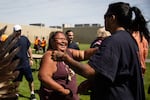
Mable Jackson (Modoc, Hupa) offers hugs and handshakes at the end of powwow at Two Rivers Correctional Institute in Umatilla, Ore., Aug. 24, 2019.
Bradley W. Parks / Bradley W. Parks
Jackson later earned a degree in adult substance abuse prevention. She’s certified in the Wellbriety Warrior Down program, which is intended to support Native Americans and Alaska Natives in recovery.
She’s also used a lot of her time out of prison to go back in. Jackson is a volunteer at Deer Ridge, where, before the pandemic, she spent several hours a week helping inmates make the same cultural connections she made many years ago.
How much can a memory carry?
For some inmates, especially those whose families and friends are absent, volunteers can be the most consistent outside presence in their lives. Pandemic-related restrictions have made religious services and other programming more difficult to access for inmates of all faiths and no faith.
Chaplain Ken Ball, from Deer Ridge, facilitates spiritual practice and faith-based exploration for all inmates at the prison. Ball said a weekly fatherhood course at the prison typically drew more than a hundred participants. Now, it’s conducted via Skype and capped at 25 people. Chaplains at other Oregon prisons like Snake River in Ontario — which has the highest COVID-19 caseload in the Department of Corrections — don’t even have technical capacity for video teleconferencing.
Ball draws a distinction between solitude and isolation. The former, he said, can bring about spiritual growth. The latter can feel like a punishment, especially in prisons.
“In isolation, all we have is memories,” Ball said. “And those can only take us so far.”
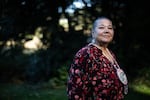
Trish Jordan (Creek) at the Red Lodge Transition Center in Oregon City, Ore., Monday, Oct. 26, 2020.
Bradley W. Parks / OPB
Since the shutdown started, Native American volunteers have shifted to building a virtual program to maintain relationships with the inmates they serve across the state.
The Red Lodge travel budget went toward building a small library of spiritual books and Native American films to loan out to prisons. They made a Native American coloring book. They hold Wellbriety meetings, 12-step programs and talking circles virtually where possible.
However, the longer the pandemic drags on, the more apparent it’s become that remote programming is no substitute for regular, person-to-person contact with inmates.
“It’s a huge void for our organization not to be able to continue to access the prisons,” Jordan said.
The deadly potential of the coronavirus is not lost on Indigenous volunteers or inmates.
Pandemic has a long, lethal history as a weapon colonizers used to wipe out Indigenous people in the Northwest. If it didn’t eliminate them, disease sickened and weakened Native communities to the point where unfair compromises with the government were less costly than battle.
The indefinite pause on in-person gatherings in prisons is a necessary but anxiety-inducing price to pay for health — for inmates, volunteers and DOC staff.
“I wish I could go in there … and let them know it’s gonna be alright,” said Owen Wallulatum (Northern Paiute, Wasco), lead volunteer at Deer Ridge.
Related: Oregon prisoners describe 'insane' wildfire evacuation, looming COVID-19 threat
Native American religious services volunteers and the Department of Corrections are hopeful in-person events will take place in 2021. Ball said the men at Deer Ridge have started craftwork for next year’s powwow.
For now, with COVID-19 keeping Oregon prisons closed off, inmates and volunteers are testing how far memories can take them.
Like last year, on a sunny Saturday in May, Indigenous inmates joined volunteers, visitors and tribal elders in Coffee Creek’s grassy worship area for a spring celebration and sacred foods blessing. Before a feast of salmon, deer, roots, huckleberries and frybread, the group circled up to offer gratitude.

Shana Cole (Klamath, Modoc, Yahooskin), right, sings for people gathered in the worship area at Coffee Creek Correctional Institute in Wilsonville, Ore., May 4, 2019.
Bradley W. Parks / OPB
Shana Cole stepped forward when a moment of silence arrived.
She pulled a prayer shawl striped with bright greens, pinks and reds a little tighter around her shoulders and through the crook of her left arm.
“This is the only one I can remember right now,” she said, locating the words to a song.
Cole stood up straight, clasped her left forearm with the opposite hand, and pulled her arms tight against her diaphragm. Her voice rose and fell while a single, heavy tear slowly carved a river down her cheek.
Those in the circle closed their eyes as the song traveled the length of the fence surrounding them, melting the chain links and the barbed wire looping above.
“They can just relax and be who they are, Native people,” Jordan said. “And it helps to feed them, it gets them through their time.”
For that moment, in that memory, the women were no longer in prison.
Words and pictures by Bradley W. Parks. Video by Arya Surowidjojo. Photo editing by Kristyna Wentz-Graff. Story editing by Jan Boyd. Additional editing by David Stuckey, Monica Samayoa and MacGregor Campbell.
Correction: This article has been updated to properly identify Mable Jackson’s and Owen Wallulatum’s tribal affiliations. OPB regrets the error.



